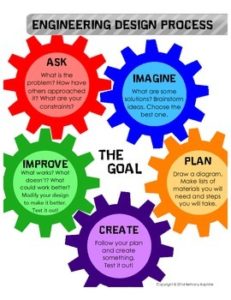
These are the steps we use for our projects.
S.T.E.M stands for Science, Technology, Engineering, and Math. Hoffman-Boston’s has a school-wide STEM focus. On a regular basis, students engage in hands-on activities that lead to learning by discovery. Many of these hands-on activities will include engineering design challenges. Students are taught that “It’s the Process, not the Product!” This gives the students an opportunity to work at their level. It makes them more confident to take risks, and allows for perseverance! We believe that each student is fully capable of success both in and out of the classroom. Throughout their years at Hoffman Boston, our students develop an understanding of the Engineering Design Process (EDP). Students in Kindergarten and First grade, learn what STEM means, and develop an understanding of how what they draw can relate to something they created. In the early grades, the students work independently, on their level to complete their challenge. In Second and Third grades, the students learn how to work through the Engineering Design Process through Project Based Learning (PBL). Students learn how to work in heterogeneous groups, and how to compromise. Students rotate through different jobs (team leader, materials manager, table police, quiet captain, and reporter). All of the students have the opportunity to be a leader in their group. In Fourth and Fifth grades, the students are able to work through PBL’s and challenges, with minimal support of the teacher.
Engineering Design Process
- ASK How can I solve the problem?
- IMAGINE I can brainstorm possible solutions, and pick the best one.
- PLAN I can make a diagram, make a list of materials, and show how those material will be used.
- CREATE I can build a model that looks like my diagram.
- IIMPROVE I can test my model to see if it solves the problem. If not, I can find a way to make it better.
- REFLECT I can evaluate what I did, and share the results with others.
Upcoming STEM Events and ways you can support your child at home!

Are you looking for ways you can engage your child at home? Here are some things you can try.
77 Simple STEM Activities is a great source. 77 Simple Family STEM Activities you can do at home
The link below: 77 (More) Simple STEM Activities for Families, is an additional resource
77 More Simple Family STEM Activities you can do at home
For grade level specific family activities, please use the link below. You will notice that many of the activities are the same for K – 2 and 3 – 5, however, there may be minor additional work required for the upper grades.
Meet Ms. Fields!!!!

My name is Teresa Fields, and I am very excited to be the STEM Coordinator, for Hoffman-Boston Elementary. Over the years, I have had the opportunity to teach in various settings in Arlington County Public schools. I believe, through STEM education, we can prepare the students for their future. The STEM initiative at the elementary school level, is essential for building the 21st century skills of critical thinking, collaboration, communication, and creativity. This year, through project based learning and various design challenges, we will use the DESIGN aspect of STEM as we learn more about real world problems.At Hoffman Boston we teach the students that with STEM, “It’s the process, not the product!”
Please feel free to contact me at [email protected] if you have questions, or it you would like additional information. To see what we are doing in the classroom and around the school, I invite you to follow me on Twitter @HFBSTEM
 Contact
Contact  Calendars
Calendars Careers
Careers Engage
Engage  District
District
